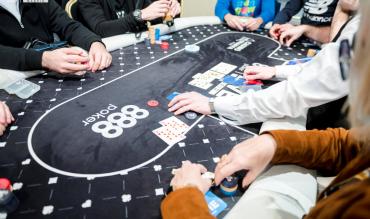Poker is a game of strategy, psychology, and skill. To excel at it, players must tap into their mental reserves and consistently perform at their best. One of the most coveted mental states in poker and any performance activity is the "flow state," also known as being “in the zone.”
In this article, I’ll explore the flow state, why it's crucial for poker players, and, most importantly, how you can achieve it to enhance your poker performance.
Understanding the Flow State
Flow, often referred to as "being in the zone," is a state of optimal human performance where individuals are fully immersed in what they are doing. It's a mental state where time seems to fly by, distractions fade into the background, and everything just clicks. When you're in flow, making decisions and taking actions feels effortless and automatic.

For poker players, achieving this state can mean the difference between a winning session and a losing one. In the flow state, your decisions are sharp, your reads are accurate, and your overall gameplay is at its peak. Being in a flow state typically leads to:
-
Intense Focus:
Your attention narrows to the game at hand, and you are fully absorbed in the present moment. -
Effortless Decision-Making:
Decisions are made with ease and confidence. You instinctively know the right moves to make. -
Enhanced Performance:
Reads are more accurate, bluffs are executed flawlessly, and gameplay is at its peak. -
Loss of Self-Consciousness:
You lose self-awareness and self-doubt, allowing you to play without hesitation. -
Enjoyment:
Flow states are often accompanied by a sense of joy and fulfillment, making the poker experience deeply satisfying.
Now that you understand what the flow state entails, let's explore how to harness this powerful mental state to your advantage in poker.
Stay in the Optimal Zone of Arousal: The Yerkes-Dodson Law
A concept in performance psychology called the Yerkes-Dodson law explains the relationship between pressure and performance. As it turns out, an optimal amount of pressure is needed to generate a flow state. The research has found that performance increases as stress (or arousal as it is called in the literature) increases, but (which is critical) only up to a point.
The Yerkes-Dodson law, often depicted as an inverted U-shaped curve, suggests an optimal level of arousal for a specific task, and performance will be at its best when arousal is within that optimal range. When arousal is too low or too high, performance tends to decline.
Now, let's look at how the Yerkes-Dodson principle applies to poker players. In poker, arousal refers to a player's mental and emotional activation level. As we have learned, the Yerkes-Dodson law implies an optimal level of arousal for peak poker performance. It cannot be too low or too high. Let’s look at how each level tends to manifest itself in-game.
-
Low Arousal (Under-Arousal):
When a poker player is under-aroused, too relaxed, or bored, their performance may suffer. They might become complacent, make careless decisions, and fail to engage with the game entirely. This can lead to missed opportunities and subpar gameplay. -
Optimal Arousal:
The sweet spot for poker players is typically within the optimal arousal range. In this state, players are alert, focused, and capable of making well-informed decisions. Their mental faculties are sharp, and they fully engage with the game. -
High Arousal (Over-Arousal):
When a poker player becomes over-aroused or overly stressed, their performance can also decline. Increased anxiety or stress levels can lead to impulsive decisions, emotional reactions, and an inability to think clearly. This can result in poor gameplay and costly mistakes.
Balancing Arousal in Poker
Because poker is a game that often involves intense decision-making moments in high-stakes situations, you must learn to manage your level of arousal. To do this, you should practice:
-
Recognizing Optimal Arousal:
Experienced players develop an awareness of their optimal arousal level. They understand when they are in the zone, fully engaged, and making the best decisions. Recognizing this state is crucial for maintaining peak performance. -
Calming Techniques:
In high-stress situations, players can use calming techniques like deep breathing, progressive muscle relaxation, or mindfulness to bring their arousal levels back to the optimal range. These techniques help reduce anxiety and refocus the mind. -
Maintaining Focus:
Staying in the optimal arousal zone requires focus and composure. Players must resist the temptation to react emotionally to wins or losses and stay disciplined. -
Preventing Over-Arousal:
It's essential to manage external stressors to prevent over-arousal. This can involve setting strict bankroll limits to avoid financial stress, taking regular breaks during long sessions, and avoiding excessive caffeine or other stimulants that can lead to heightened arousal. -
Training and Preparation:
Consistent training and preparation can help players feel more comfortable in high-stress situations. As they gain experience and confidence, they are less likely to become over-aroused when facing challenging opponents or critical decisions.
It's important to note that individual players may have different optimal arousal levels. Some players perform at their best when relatively calm and composed, while others thrive in high-pressure situations. Understanding one's optimal arousal level and developing strategies to maintain it is a personal journey for each poker player.

In summary, the Yerkes-Dodson principle provides valuable insights for poker players by emphasizing the importance of managing arousal levels for optimal performance. Players who learn to recognize their optimal zone of arousal and apply techniques to stay within it are better equipped to make sound decisions, maintain composure, and ultimately enhance their poker performance.
The Path to Poker Flow
There are several psychological strategies that you can use before and during play to increase your chances of maintaining a flow state.
Set Clear and Achievable Goals
Begin by setting clear, specific goals for your poker session. Knowing what you want to achieve helps keep you focused and motivated. Your goals should be attainable and tailored to your current skill level.
Cultivate Mindfulness and Present-Moment Awareness
Practice mindfulness techniques to stay in the present moment during your poker game. Before the session starts, take a few moments to center yourself through deep breathing or a brief body scan. Mindfulness strategies can help you maintain focus and reduce anxiety.
Balance Challenge and Skill
Recognize the importance of the balance between the challenge level of the game and your skill level. The flow state often occurs when the challenge slightly exceeds your skill. Choose games or opponents that provide the right level of challenge to keep you engaged. If you select games that are too easy for you, boredom is the most likely result. Anxiety is the most common outcome if the games are outside your skillset.
Create a Distraction-Free Environment
Eliminate distractions in your playing environment. Turn off notifications, close unnecessary tabs on your computer, and create a quiet, focused space to play. A clutter-free environment also promotes deep concentration.
Develop a Pre-Game Routine
Establish a pre-game routine that includes relaxation techniques, visualization, and positive self-talk. This routine can help you get into the right mindset before playing. Visualizing successful gameplay can boost your confidence and set a positive tone for the session.
Manage Your Emotions In-Game
Accept that negative thoughts and emotions may arise during the game, but instead of fighting them, acknowledge them. Commit to your chosen goals and take aligned actions in the game. This approach allows you to stay mentally resilient and focused despite challenges.
Stay in the Optimal Zone of Arousal
Pay attention to your emotional state during the game. Use techniques like deep breathing or positive visualization to stay within this zone. Too much anxiety or too little arousal can disrupt your flow.
Cultivate Patience
One of the biggest pitfalls in poker is impatience. Rushing decisions, especially in high-pressure moments, can lead to poor choices and a lack of flow. Train yourself to be patient and give each hand the time it deserves for thoughtful analysis.
Keep a Flow Journal
Consider keeping a journal where you record your flow experiences and what led to them. This can help you identify patterns and strategies that work for you. A flow journal can also be valuable for self-reflection and continuous improvement.
Consistency is Key
Consistency is the bedrock of success in poker. Establish a routine that includes regular practice, study, and self-care. By consistently applying the above-mentioned strategies, you increase your chances of experiencing flow in poker more frequently.
Conclusion
Achieving the flow state in poker is like unlocking the secret to peak performance. It's a mental state where your decisions are sharp, your focus is unwavering, and your gameplay is at its best. You increase your chances of being in flow by setting clear goals, embracing mindfulness, monitoring your emotions, and game-selecting well.
Remember that flow is not something you can force; it emerges when the right conditions are met. These actionable steps and tips can allow flow to occur more frequently in your poker sessions. With dedication and the right mindset, you can become a true master of the flow state in poker.


